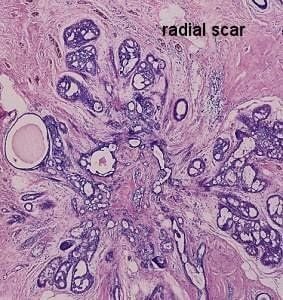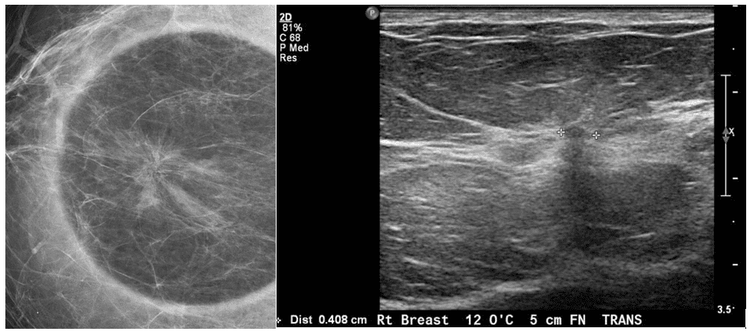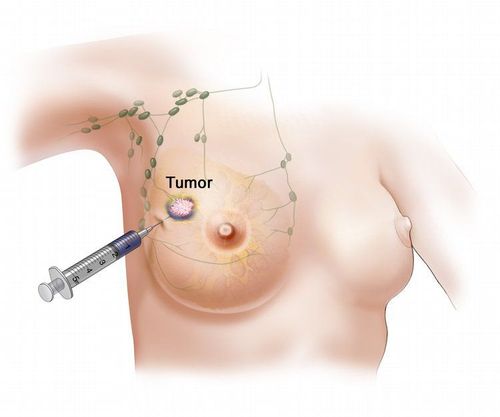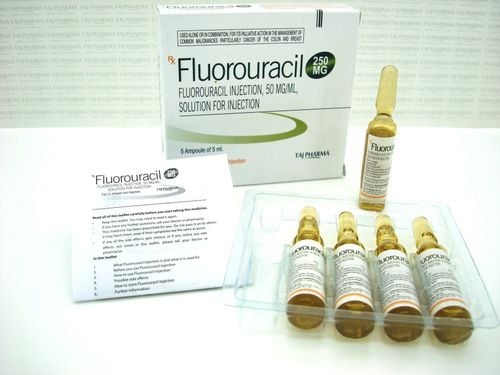This is an automatically translated article.
Posted by Master, Doctor Tong Diu Huong - Diagnostic Imaging Department - Vinmec Nha Trang International General HospitalRadiant scarring is a benign proliferative disease of the breast. Proposed causes include local inflammatory response and chronic ischemia with delayed infarction.
1. What is Radiant Scar?
A radial scar, also known as a complex sclerosing lesion, is an asterisk-like proliferative breast lesion. It is not associated with surgical scarring. It is an idiopathic ductal sclerosis hyperplasia.Epidemiology:
The reported incidence of radiating scarring is 0.1-2.0 per 1,000 screening mammograms. Radiant scarring is very rare in women under 40 and over 60. Most common in women aged 41-60 years.
2. Clinical Manifestations of Radiant Scars
Radiant scars are usually not palpable on physical examination. Only about 25% of radiating scars are palpable. Radiant scars do not cause skin thickening or skin shrinkage. Lesions are usually small and detected by mammography when they are at least 5 mm in size. Lesions <1cm are referred to as radial scars, and larger lesions are commonly referred to as complex sclerosing lesions or radiative fibrosis. Pathology:Radiant scarring is a benign proliferative disease of the breast. Proposed causes include local inflammatory response and chronic ischemia with delayed infarction. Histopathologically radiating scars contain hyperplastic tissue cells and a central fibrous core, with diffuse radiating tubular structures (the margins are dendritic), resembling infiltrative carcinoma. This tubular formation has two rows of cells: epithelial and muscle epithelial. The malignancy potential is more than two times greater than that of the general population without radiating scars.

Atypical ductal hyperplasia Atypical lobular hyperplasia
3. Photographic characteristics
3.1 Mammography Radiant scars have a dendritic appearance similar to breast carcinomas, but the center tends to be radiolucent (lower attenuation than the mass). The breast tissue behind the lesion is mostly visible through the lesion. Relatively low central attenuation is the difference between carcinomas and radial scars (Carcinomas present on mammograms have hyperattenuating centers).The spines that run out from the center are usually longer and thinner than in carcinoma. The dendrites are described as long, thin, radiolucent line-like structures running radially, on a background of radiolucent adipose tissue forming a black star image.
Microcalcifications can be seen but rarely in radial scars.
Unlike carcinoma, radiative scarring is not accompanied by signs of skin thickening or skin shrinkage. No fibrosis was seen in radiative scars.
Its mammogram appearance is similar to a breast scar after surgery.

3.3 MRI Similar features in the aforementioned modalities. There are convoluted structures and precipitates. Non-enhanced lesions lead to a benign process. Enhancing lesions suggest underlying malignancy.
4. Treatment and prognosis
Radiant scarring is considered a high-risk breast lesion and must be differentiated histologically from carcinoma. FNA and core biopsy can evaluate for associated malignancy. Lesions are usually biopsied and excised.
5. Differential diagnoses
On the mammogram, it is necessary to distinguish it from some other lesions such as:Breast cancer: An increased density, dendritic shape. The spines are usually shorter, thicker, and have retraction of the surrounding breast parenchyma. However, sometimes invasive lobular carcinoma, due to lack of e-cadherin and diffuse infiltration of tumor cells, may not be able to distinguish it from radiation scarring. Postoperative breast scarring: In practice, this is rarely a cause of confusion as it can be easily differentiated on the basis of patient history and physical examination. At Vinmec International General Hospital, there is a Breast Cancer Screening Package to help detect breast cancer early even when there are no symptoms.
Breast cancer screening package at Vinmec for the following subjects:
Female customers, over 40 years old. Customers wishing to be able to screen for breast cancer Customers are at high risk of cancer – especially customers with a family history of breast cancer. Women of reproductive age, perimenopause and menopause. Women who are having symptoms of breast cancer such as: pain in the breast, lump in the breast, etc
Please dial HOTLINE for more information or register for an appointment HERE. Download MyVinmec app to make appointments faster and to manage your bookings easily.
MOREHow are HER2 breast lumps tested? Risk factors for Paget's disease of the breast Advances in the treatment of triple negative breast cancer














